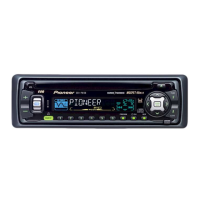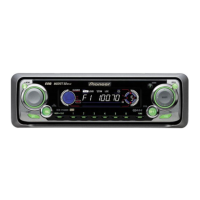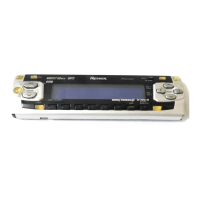Do you have a question about the Pioneer DEH P4800MP and is the answer not in the manual?
General information and warnings provided to the user of the unit.
Compliance information specific to the Canadian version of the unit.
Details regarding tuner frequency allocation and reception in North America.
Explains the manual's purpose and highlights the importance of warnings.
Contact information for after-sales support and warranty inquiries.
Instructions and benefits for registering your Pioneer product online.
Information on the compatibility and playback of standard audio CDs.
Details regarding playback of MP3, WMA, and WAV audio files.
Explanation of WMA (Windows Media Audio) compression technology.
Step-by-step guide for inserting the battery into the remote control.
Instructions on how to operate the unit using the remote control.
Information on detaching the front panel to prevent theft.
Detailed instructions for safely removing the detachable front panel.
Instructions for securely reattaching the front panel to the unit.
Identification and function of buttons on the main unit.
Explanation of the buttons and functions on the remote control.
Details on SOURCE, PAUSE, and ATT buttons on the remote.
Steps to power on the unit by selecting an audio source.
Procedure for powering down the unit.
Guide to choosing between various available audio sources.
Basic steps for tuning into radio stations.
Explanation of indicators like Band, Frequency, Preset, and Stereo.
Methods for manually tuning or automatically seeking stations.
Introduction to advanced tuner features and display indicators.
Instructions for saving and retrieving preset radio stations.
Using local seek tuning to find stations with good reception.
Using BSM to automatically store the six strongest radio stations.
Basic steps for playing a standard audio CD.
Explanation of EQ, Play Time, and Track Number indicators.
Instructions for fast forward/reverse and skipping tracks.
Introduction to advanced functions and display indicators.
How to repeat the current track or the entire disc.
How to play tracks from a CD in a random order.
How to play the first 10 seconds of each track on a CD.
How to temporarily pause and resume CD playback.
Adjusting sound quality using COMP and BMX functions.
Switching between fast search and 10-track search modes.
Navigating through tracks in blocks of ten on a disc.
How to input and store custom titles for CDs.
How to view the stored titles for inserted CDs.
Viewing embedded text data from CD TEXT compatible discs.
Basic steps for playing MP3, WMA, and WAV files from discs.
Explanation of indicators for EQ, Folder, Time, Track, WMA, and MP3.
Instructions for selecting folders, fast forward/reverse, and skipping files.
Key considerations for playing discs with various audio file formats.
Introduction to advanced functions like repeat and random play.
How to repeat files by folder, track, or the entire disc.
How to play files randomly within selected repeat ranges.
Previewing the beginning of tracks within folders or discs.
How to temporarily pause and resume playback of audio files.
Adjusting sound quality with COMP and BMX settings.
Switching between fast search and 10-track search modes.
Navigating through tracks in increments of ten within a folder.
Viewing file, track, artist, and album details for MP3/WMA files.
Viewing file name and sampling frequency for WAV files.
How to scroll long text information for files on the display.
Basic steps for playing CDs using the multi-CD player.
Explanation of EQ, Disc Number, Play Time, and Track Number indicators.
How to select a disc from the multi-CD player magazine.
Instructions for fast forward/reverse and skipping tracks.
Introduction to advanced functions and display indicators.
How to repeat tracks by disc or the entire magazine.
How to play tracks in a random order within repeat ranges.
Previewing tracks on selected discs or within the magazine.
How to temporarily pause and resume CD playback.
How to create custom playlists of favorite tracks.
How to play tracks from a created ITS playlist.
How to remove tracks or entire CDs from an ITS playlist.
How to input and store custom titles for CDs in the player.
How to view the stored titles for inserted CDs.
How to scroll long text information for discs on the display.
Viewing embedded text data from CD TEXT compatible discs.
Overview of available audio adjustment features.
Explanation of indicators for Audio, Custom, FIE, SW, and Loudness.
Adjusting front/rear and left/right speaker balance for optimal sound.
Overview of equalizer functions and selecting curves.
How to select and apply preset equalizer curves.
How to adjust equalizer bands and save custom settings.
Adjusting center frequency and Q factor for equalizer bands.
Enhancing low and high frequencies at low volume levels.
How to turn the subwoofer output on or off.
Adjusting subwoofer cut-off frequency and output level.
Filtering low frequencies from front and rear speakers.
Enhancing bass levels for a more powerful sound.
Enhancing front soundstage by adjusting rear speaker output.
Adjusting volume levels between sources for consistency.
Overview of initial system setup options.
Instructions for setting the current time on the unit.
Enabling or disabling the warning tone for panel removal.
Activating or deactivating auxiliary input sources.
Configuring rear output for speakers or subwoofers.
How to toggle the clock display on the unit's screen.
Controlling connected auxiliary audio equipments.
Methods for connecting auxiliary audio inputs via mini plug or RCA.
Choosing an auxiliary input as the active audio source.
Customizing the display name for AUX sources.
Overview of controlling an optional XM satellite tuner.
Displays for XM tuner information and current channel number.
Changing the type of information shown on the XM display.
How to scroll long text information related to XM data.
Changing XM channel selection mode to number or category.
Overview of controlling an optional SIRIUS satellite tuner.
Displays for SIRIUS tuner information and current channel number.
Changing SIRIUS channel selection mode to number or category.
Instructions for switching SIRIUS channel select modes.
Lists common error codes, their causes, and recommended actions.
Instructions for proper use and maintenance of CDs and the player.
Important considerations and compatibility for CD-R/RW discs.
General information on supported audio file formats.
Details on MP3 file compatibility, ID3 tags, and playback quality.
Details on WMA file compatibility, encoding versions, and quality.
Details on WAV file format, encoding, and sampling frequencies.
Explanation of folder structure and playback limitations.
Definitions for terms like Bit Rate, ID3 Tag, ISO9660, LPCM, MP3, etc.
Definitions for file writing methods and audio formats.
Technical details: power, grounding, consumption, dimensions, weight.
Continuous power, load impedance, preout, and equalizer parameters.
Frequency range, sensitivity, signal-to-noise, and distortion.
Frequency range for AM radio reception.
System type, usable discs, signal format, and frequency characteristics.
Usable sensitivity and signal-to-noise ratio for radio tuning.
| DIN Size | Single DIN |
|---|---|
| CD Playback | Yes |
| MP3 Playback | Yes |
| WMA Playback | Yes |
| Radio Tuner | AM/FM |
| Aux Input | Yes |
| USB Port | No |
| Bluetooth | No |
| Detachable Face | Yes |
| Sub Preamp Output | Yes |
| CEA-2006 Compliant | Yes |
| ID3 Tag Display | Yes |
| Radio Data System (RDS) | Yes |
| CD-R Playback | Yes |
| CD-RW Playback | Yes |
| Display Type | LCD |
| Clock | Yes |
| Power Output | 50 watts x 4 channels |
| RMS Power Output | 22 Watts x 4 |
| Built-in Equalizer | Yes |
| Preset Stations | 18 FM, 6 AM |
| Dimensions (W x H x D) | 178 x 50 x 160 mm |











